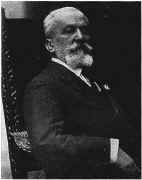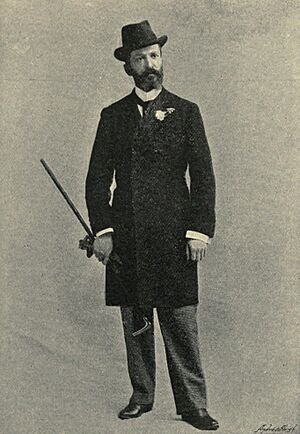Luigi Mancinelli facts for kids
Luigi Mancinelli (born February 5, 1848 – died February 2, 1921) was a talented Italian conductor, cellist, and composer. He started his career in Italy, becoming well-known in cities like Perugia and Bologna. After 1886, he mostly worked in other countries. He was the main conductor at the Royal Opera House, Covent Garden in London and at the "Old Metropolitan" Opera House in New York. He also worked in Madrid, Rio de Janeiro, and Buenos Aires.
Mancinelli was highly respected for conducting Italian operas. He was also praised for his work with German and French operas. Even though he was a famous conductor, his own musical compositions were not as successful. None of his works became a regular part of the music repertoire.
Contents
Life and Career Highlights
Early Musical Journey
Luigi Mancinelli was born in Orvieto, a town in central Italy. He learned to play the organ and cello from his older brother, Marino. Marino later became a famous conductor himself. Luigi played the cello in the Orvieto cappella and in the orchestra of the Teatro della Pergola in Florence. In Florence, he also studied how to compose music with Teodulo Mabellini.
In 1874, he moved to the Teatro Morlacchi in Perugia. There, he was the main cellist and an assistant conductor. He got his first chance to conduct the opera Aida when the usual conductor was unable to perform. A theater manager named Vincenzo Jacovacci saw him conduct and hired Mancinelli for the Teatro Apollo in Rome. He conducted there until 1881.
Luigi quickly became famous. In 1877, the writer Boito called him the perfect conductor for his opera Mefistofele. He was also seen as the best conductor for Wagner's operas in Italy. Wagner himself thought Mancinelli was very good.
Global Conducting Career
In July 1878, Mancinelli conducted in Paris for the first time. In Italy, he worked mainly in Bologna. He conducted operas at the Teatro Comunale. He also led the music at the basilica of San Petronio and taught at the Liceo Musicale. One of his students there was Giacomo Orefice.
Throughout his life, Mancinelli composed music in addition to conducting. His first opera, Isora di Provenza (1884), was liked in Bologna but did not do well in Naples two years later. After this, Mancinelli's career mostly took him outside Italy.
In June 1886, he conducted a concert in London. It included Beethoven's Fifth Symphony and some of his own music. He left his jobs in Bologna and accepted an invitation from a manager named Augustus Harris. Harris asked him to be a conductor for a season in London in 1887. This season featured many famous international singers and a wide range of Italian, French, Austrian, and German operas.
Harris then took over the Royal Opera House, Covent Garden in 1888. He made Mancinelli the chief conductor, a job he held until 1905. Mancinelli quickly made the music quality much better. A French critic noted that "Under M. Mancinelli's baton, his orchestra has achieved the homogeneity that it lacked at first; now it is worthy of Covent Garden."
When Harris and Mancinelli started, the opera house was called "The Royal Italian Opera House." Operas from any country were sung in Italian. For example, Die Zauberflöte was performed as Il flauto magico. Slowly, this rule changed. Operas began to be sung in their original language. By the 1890s, Mancinelli was conducting Faust and Roméo et Juliette in French. He also conducted Lohengrin in German. One important British premiere Mancinelli conducted was Verdi's last opera, Falstaff, in May 1894.
Mancinelli was also the chief conductor at the Madrid opera from 1887 to 1893. He then became the chief conductor at the Metropolitan Opera House (the "Old Met") in New York from 1893 to 1903. In New York, he mostly conducted Italian or French operas. These included some less common ones like Semiramide and Orfeo ed Euridice. He also conducted German operas like Lohengrin and Tannhäuser, which were sung in Italian at the Met at that time.
Like at Covent Garden, Mancinelli introduced Falstaff to the Met. He also conducted the first Met performance of the popular double-bill of Cavalleria rusticana and Pagliacci. Other operas that were first performed at the Met under Mancinelli included The Magic Flute, Don Giovanni, and La bohème.
Mancinelli continued to conduct opera in Italy until 1911. He also conducted seasons at the Teatro Nacional de São Carlos, Lisbon, from 1901 to 1919–20. In 1905, he was at the Rio de Janeiro opera. In May 1908, he conducted Aida to open the new Teatro Colón in Buenos Aires. He returned there in 1909, 1910, and 1913.
Personal Life
In 1881, Mancinelli married Luisa Cora in Turin. He passed away in Rome on February 2, 1921, at the age of 72.
Musical Compositions
Even though people saw Mancinelli mainly as a conductor, he took his composing very seriously. He was disappointed that his compositions did not become very popular. For example, his opera Ero e Leandro, first performed in 1896, was later shown in Madrid, London, New York, and several Italian cities. However, it did not stay in the regular opera repertoire.
Music experts believe that his compositions were not as successful because his dramatic style was different from the popular Italian opera styles of his time. He often treated his characters in a more abstract way and was not as good at creating very memorable melodies.
Operas
- Isora di Provenza (3 acts, 1884)
- Ero e Leandro (3 acts, 1896)
- Paolo e Francesca (1 act, 1907)
- Sogno di una notte d'estate (3 acts, 1919)
Other Stage Works
- Messalina (Music for a play, 1876)
- Cleopatra (Symphonic music for a play, 1877)
- Tizianello (Five pieces for a comedy, 1880)
- Isaia (Cantata, a vocal work, 1887)
Film Scores
- Frate Sole (Music for a film, 1918)
- Giuliano l'Apostata (Music for a film, 1920)
See also
 In Spanish: Luigi Mancinelli para niños
In Spanish: Luigi Mancinelli para niños



